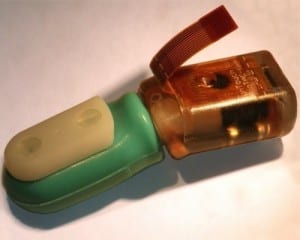Biomimetic fingertips need to be durable in a wide range of environments, and provide grip and tactile sensing. A new study presents an in-depth analysis of the properties of various candidate elastomers and fluids for use in the multimodal tactile sensor, BioTac.
The BioTac from SynTouch LLC is designed to act as an artificial fingertip for prostheses and robots. It consists of a rigid core containing a thermistor, platinum electrodes and a pressure sensor. This is encased in a conductive fluid surrounded by a skin formed of an elastomer. Any force on the elastomer alters the thickness of the fluid which in turn changes the impedance of electrodes.
The advantage of this system is that there is no sensor in the skin, thus when wear renders the elastomer no longer usable it is easy to replace. The elastomer must be low cost and readily deformable, as well as preventing leakage, diffusion loss, and chemical interactions with the fluid. Additionally, its lifetime will be extended the more resistant it is to cuts and abrasive wear. As for the fluid, its conductivity should be between 100 and 1000 Ω cm in order to reach the sought after dynamic range without excessive electrical noise. A fluid of high lubricity and low viscosity is also desirable.
Dipayon Roy and colleagues at the University of Southern California report the mechanical properties of several silicones and urethanes, and the diffusion of four fluids (solutions of NaBr in water, 1,2-propanediol, poly(ethylene glycol)-200 and poly(ethylene glycol)-400) through them. The performance of each varied depending on the environmental conditions.
In this work the Silastic S silicone elastomer combined with a solution of NaBr in poly(ethylene glycol)-200 and water provides a good balance between each requirement and gives a construct whereby any changes that take place do so slowly and do not prevent the BioTac from functioning. At the same time, zeroing or calibration algorithms can be used to compensate for property fluctuations on a timescale faster than the rate of the environmental effects. More generally, the study provides guidance for other fluid-based tactile sensing and gripping.


















